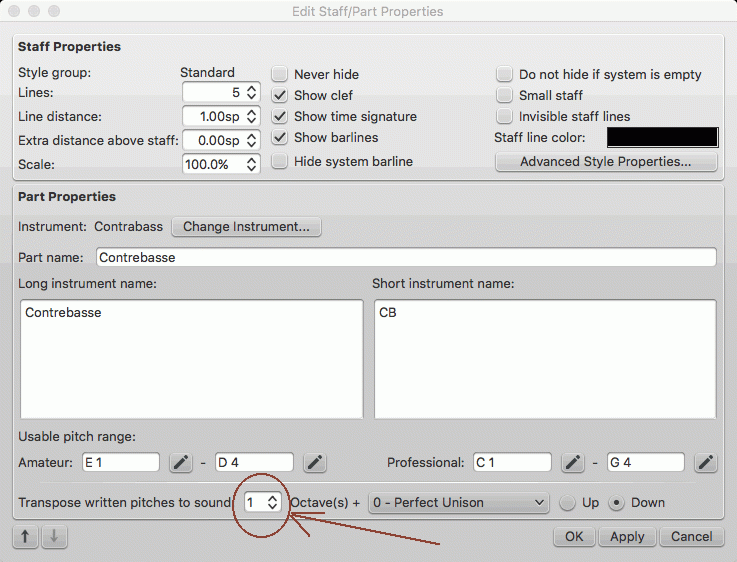Part Properties>Transpose Written Pitches Query
Am a little confused. Could a MuseScore Magician please explain this to me?...
I understand that the Contrabass is a transposing instrument. It sounds an octave lower than written.
After I have defined the stave’s instrument in Edit Staff/Part Properties>Part Properties, I see this:

Masterscores presented in ‘concert pitch’ (all pitches sound as written), usually include the caveat: ‘except for the usual octave transpositions’ [e.g. piccolo, glockenspiel, timpani, tuba and contrabass etc.]).
In the above window, does the line ‘Transpose written pitches to sound’ apply to the sound of the playback instrument plugin in MuseScore, or to the transposition of the generated player part? I guess the latter.
The reason I ask this, is that the Tuba is a transposing instrument (sounds an octave lower than written), but its own preset Part Properties in MuseScore show no transposition of pitches in the Part Properties window. If this were the case, then lots of low ledger lines would be appearing unnecessarily in its stave in the masterscore and I'm not sure how one would correct that.
Many thanks in advance!
Comments
there is no playback instrument plugin
That Tuba setting might be a bug, not sure.
The basic BBb or C Tuba is not a transposing instrument. It plays as sounded. There are transposing tubas such as the Eb and the treble clef tuba (which is actually any BBb Tuba playing music written on the treble clef). The transposed fingerings are the same as a baritone and trumpet to make the transition to the tuba easier for these musicians. There are also contrabass tubas that transpose down an octave, but they are quite rare compared to other tubas.
The words explaining the transposition in the dialog you show are very confusing to me as well. The double bass and contrabass are both included in the default instruments. They both have the same octave transposition. The transposition is for the instrument to sound 1 octave below what is written, which is proper for the contrabass.
There are two different ways octave transpositions can be handled in MuseScore. One is to actually treat it as transposing, the other is to use one of the "octave clefs". Some instruments use one approach, others use the other.
If you want to produce a concert pitch score that nonetheless includes the octave transpositions, then use the octave clef for concert pitch mode. Clefs are managed separately for concert and transposed modes.
To answer the question literally, the wording of the dialog is meant to be taken literally - it is about how the pitches "sound". So, if you enter a written middle C, it will sound one octave lower. Unless you turn on "Concert Pitch", in which case WYSIWYG. So the part will show middle C if concert pitch is disabled (the norm), but will show C below that is concert pitch is enabled. If you have set it up to use an octave clef, then middle C is the C on the staff, not the C a ledger line above.